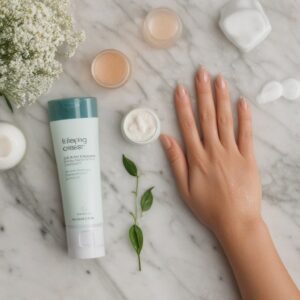Dermatologists Unveil the Right Nighttime Skincare Routine Order
A good night’s sleep is essential for overall health—including your skin. But what if your nighttime skincare routine isn’t giving you the glowing, rejuvenated skin you’ve been dreaming of?
This comprehensive guide on GlowGuideHub explores the dermatologist-recommended order for your bedtime skincare routine, specifically tailored for adults and teens. Backed by expert insights, credible sources, and my personal experiences, it offers effective solutions for every skin type and age group.
Whether you’re struggling with hyperpigmentation, acne, or dry skin, this guide offers actionable tips for every skin type. Let’s unlock the secrets to a truly effective night routine that transforms your skin while you sleep.
The Power of a Proper Nighttime Skincare Routine
Not long ago, I struggled with uneven skin tone and unexpected breakouts despite following a basic skincare routine. I soon learned that the order in which I applied my products could make a difference.
Dermatologists now emphasize that a well-structured bedtime skincare routine helps repair the day’s damage and primes the skin for overnight regeneration.

In this post, we’ll cover:
- The science behind your skin’s nighttime repair processes.
- A step-by-step look at the Dermatologist-Recommended Night Routine.
- Specialized routines for specific concerns: hyperpigmentation, acne-prone skin, and dryness.
- A detailed comparison of Night Cream vs Sleeping Mask.
- Expert insights, personal experiences, and credible research to help you fine-tune your routine.
Whether you’re a skincare newbie or a seasoned enthusiast, this guide will help you achieve the radiant, healthy skin you deserve.
Understanding the Importance of a Bedtime Skincare Routine

The Science Behind Overnight Skin Repair
When you sleep, your body goes into repair mode, and your skin is no exception. The skin’s natural repair process is most active at night, making your bedtime skincare routine critical.
Here’s why:
- Cellular Regeneration: At night, your skin ramps up cell turnover. This means the dead skin cells on your surface are replaced with new, fresh ones.
A proper nighttime routine helps remove impurities and primes your skin for this cellular regeneration.
- Enhanced Product Absorption: With clear pores and skin prepared, your active ingredients can penetrate more deeply and work more effectively.
- Moisture Retention: Your skin loses less moisture overnight than during the day. Hydrating products can maximize this benefit, keeping your skin plump and smooth.
According to the American Academy of Dermatology, the order in which you apply your products is as important as the products themselves. The correct sequence ensures that each product can deliver its maximum benefits.
Personal Experience: Learning the Right Order
I remember spending years applying my serums and moisturizers randomly, hoping for that elusive glow. It wasn’t until I consulted with a dermatologist and restructured my routine that I saw real improvements.
Not only did my skin tone even out, but breakouts and irritation became a thing of the past. This journey taught me that a deliberate, step-by-step skincare routine can transform your skin.
The Dermatologist-Recommended Night Routine
Creating an effective nighttime skincare routine is like assembling a well-tuned orchestra: each product plays a specific role, and the timing of each application is key. Here’s a breakdown of a Dermatologist-Recommended Night Routine:

Step 1: Double Cleansing
Why It’s Important:
Double cleansing is the first and perhaps the most crucial step. It involves using an oil-based cleanser followed by a water-based cleanser to thoroughly remove makeup, sunscreen, and impurities.
How to Do It:
-
Oil-Based Cleanser:
Start by massaging an oil-based cleanser into your dry face. This step helps dissolve makeup and sebum.
-
Water-Based Cleanser:
Rinse with a gentle water-based cleanser to remove any residual oil and dirt.
Step 2: Toning
Purpose:
Toners help restore your skin’s pH balance and remove any lingering impurities your cleanser might have missed.
Tips:
- Use an alcohol-free toner to avoid over-drying your skin.
- Pat the toner onto your face with your fingertips for better absorption.
Step 3: Applying Active Ingredients (Serums & Treatments)
At this stage, it’s time to address specific skin concerns with targeted treatments.
For Hyperpigmentation:
-
Night Routine for Hyperpigmentation:
Use serums containing vitamin C, niacinamide, or alpha hydroxy acids (AHAs) to help fade dark spots.
-
Personal Tip:
I found that alternating between a vitamin C serum and a glycolic acid treatment every other night really helped in reducing my dark spots over time.
- For more detailed advice on treating hyperpigmentation, check out Healthline’s guide on hyperpigmentation treatments.
For Acne-Prone Skin:
-
Natural Skincare Routine for Acne-Prone Skin:
Look for salicylic acid or tea tree oil products, which help prevent breakouts while maintaining a gentle formula.
-
Personal Insight:
My prone acne skin responded well to a lightweight, natural serum enriched with green tea extract. It calmed inflammation without over-stripping moisture.
- Learn more about natural approaches on Dermstore’s skincare blog.
For Dry Skin:
-
Step-by-Step Skincare Routine for Dry Skin:
Incorporate hydrating serums with hyaluronic acid and ceramides to lock in moisture.
-
My Experience:
During winter, I noticed my skin becoming painfully dry, until I switched to a hyaluronic acid serum that transformed my skin into a more supple, well-hydrated canvas.
Step 4: Eye Cream
Why It Matters:
The delicate skin around the eyes needs special care. An eye cream helps reduce puffiness, dark circles, and fine lines.
Application Tips:
- Use your ring finger to tap the eye cream around your orbital bone gently.
- Ensure you don’t get too close to the lash line to avoid irritation.
Step 5: Moisturizing
The Final Seal:
A good moisturizer locks in all the active ingredients and provides the hydration needed for overnight repair. Look for products that suit your skin type—whether you need a rich cream for dry skin or a lighter gel for oily or acne-prone skin.
Pro Tip:
If you have combination skin, consider using a heavier moisturizer on dry areas and a lighter one on oily zones.
Step 6: The Lip Balm
Don’t Forget Your Lips:
Your lips deserve attention, too. Apply a hydrating lip balm to keep them soft and supple, especially in dry climates or during colder months.
Customizing Your Routine: Tailored Approaches for Different Skin Concerns
No two skins are alike. While the above steps provide a comprehensive routine, you might need to adjust the order or the products based on your specific concerns. Below are specialized routines that cater to various skin issues:

1. Night Routine for Hyperpigmentation
Hyperpigmentation, characterized by dark spots and uneven skin tone, requires targeted treatment.
Key Steps:
- Cleanse and Tone: Ensure that your skin is clean and prepped.
- Vitamin C or Niacinamide Serum: Both ingredients are renowned for brightening the skin and reducing dark spots.
- Chemical Exfoliants: Consider gentle AHAs or BHAs once or twice weekly to encourage cell turnover.
- Moisturize: Seal your activities with a nourishing moisturizer.
Expert Tip:
According to WebMD, consistency is key when addressing hyperpigmentation. It might take several weeks to see noticeable improvements.
2. Natural Skincare Routine for Acne-Prone Skin
Acne-prone skin benefits from a routine that reduces inflammation and prevents breakouts without harsh ingredients.
Key Steps:
- Double Cleanse: Remove oil-based impurities to prevent clogged pores.
- Gentle Toner: An alcohol-free toner with witch hazel can help reduce excess oil.
- Acne-Fighting Serum: Ingredients like salicylic acid or tea tree oil work wonders.
- Non-Comedogenic Moisturizer: A lightweight, oil-free moisturizer that hydrates without clogging pores.
Personal Experience:
I once experimented with several products until I found a serum with green tea extract that worked perfectly for my acne-prone skin. The natural formulation not only prevented breakouts but also minimized redness and inflammation.
3. Step-by-Step Skincare Routine for Dry Skin
Dry skin demands a routine that maximizes hydration and restores the skin’s moisture barrier.
Key Steps:
- Hydrating Cleanser: Use a cream-based cleanser that cleans without stripping moisture.
- Hydrating Toner: Opt for a toner with hydrating ingredients like glycerin or aloe vera.
- Hyaluronic Acid Serum: This powerful hydrating ingredient attracts moisture to the skin.
- Rich Moisturizer or Night Cream: A thicker cream that provides deep hydration.
- Sleeping Mask (Optional): For an extra boost, apply a sleeping mask to lock in moisture throughout the night.
Expert Advice:
Healthline says incorporating hyaluronic acid into your routine can significantly improve hydration levels, especially during harsh weather conditions.
Night Cream vs Sleeping Mask: Which Is Right for You?
Night creams and sleeping masks hydrate and repair your skin overnight, but they work differently. Night creams are lightweight, daily moisturizers for consistent hydration, while sleeping masks are thicker, occlusive treatments, used 2–3 times a week for deep nourishment. Choosing the right one depends on your skin type, concerns, and routine.
Learn how to pick the best overnight skincare for glowing, healthy skin.
Which One Should You Choose?
Night Cream:
Ideal for those seeking a consistent routine that combines hydration with active ingredients designed to promote anti-aging. It’s lighter than a sleeping mask, making it ideal for normal to combination skin.
Sleeping Mask:
It is best suited for those with severely dry skin. Use it on nights when your skin feels extra thirsty. Its occlusive nature seals in moisture and maximizes hydration.
Personal Insight:
Depending on the season, I’ve alternated between a night cream and a sleeping mask. During winter, my skin craved the extra hydration provided by a sleeping mask, while a lightweight night cream was sufficient in the milder months.
Comparison Table: Night Cream vs Sleeping Mask
| Feature | Night Cream | Sleeping Mask |
|---|---|---|
| Texture | Rich yet non-greasy; designed for nightly use | Thicker, more emollient, intended for deep hydration |
| Primary Benefit | Provides a balance of hydration and anti-aging ingredients | Intensive moisture boost creates a protective barrier |
| Usage Frequency | Every night | 2-3 times per week or as needed |
| Best For | All skin types; ideal for regular maintenance | Dry, dehydrated skin needing an extra hydration boost |
| Application Time | Applied as the final step in your routine | Often left on overnight as the last step |
Integrating Additional Tips for an Effective Nighttime Routine
A well-crafted skincare routine goes beyond the products you apply. Here are some additional lifestyle tips that can enhance your nighttime regimen:
Optimize Your Sleep Environment
- Invest in Quality Sleep:
Adequate sleep is essential for skin repair. Aim for 7–9 hours of uninterrupted sleep each night. - Adjust Room Temperature:
A calm, comfortable room helps maintain your body’s natural rhythms and improves skin repair. - Humidifier Use:
In dry climates or during winter, a humidifier can help maintain moisture levels, preventing your skin from drying out overnight.
Diet and Hydration
- Stay Hydrated:
Drinking water throughout the day supports overall skin health. Herbal teas in the evening can be both soothing and hydrating. - Balanced Diet:
Foods rich in antioxidants, vitamins, and omega fatty acids support skin regeneration. Incorporate fruits, vegetables, nuts, and seeds into your meals.
Stress Management
- Unwind Before Bed:
High stress levels can lead to skin flare-ups. To calm your mind and body, consider relaxation techniques such as reading, meditation, or a warm bath. - Consistent Routine:
Establishing a regular bedtime routine signals to your body that it’s time to relax and repair. This consistency can contribute to better sleep and, by extension, healthier skin.
Personal Experience: Transforming My Nighttime Routine
I still vividly remember the days when my nighttime routine was more of an afterthought than a ritual. I would hurriedly splash on whatever products I had and rush off to bed—only to wake up with dull, irritated skin.
The turning point came after a consultation with a dermatologist, who emphasized the importance of a proper order and the right ingredients.
Here’s what changed for me:
- Consistency:
I committed to a strict routine, following each step methodically. Over time, I noticed that my skin looked better in the mirror and felt smoother and more resilient. - Targeted Treatments:
I addressed my specific concerns by incorporating specialized products, like a hyaluronic acid serum for dryness and a vitamin C serum for hyperpigmentation. The difference was remarkable. - Seasonal Adjustments:
I learned to adapt my routine to the changing seasons. In winter, I opted for a richer night cream and occasionally a sleeping mask, while in the summer, I leaned towards lighter formulations. - Expert Guidance:
Following dermatologist recommendations and credible sources, such as Dermatology Times and Healthline, helped me understand the science behind each product and its proper use.
These changes transformed my skin, boosting my confidence and teaching me that a well-executed nighttime routine is a form of self-care that pays dividends every morning.
Bringing It All Together: The Ultimate Nighttime Routine
To sum up, a well-organized night-time skincare routine isn’t just about the products you use; it’s about the order in which you use them and how they work in synergy.
Here’s a quick recap of the ideal routine:
- Double Cleanse: Remove makeup and impurities with an oil-based cleanser followed by a water-based cleanser.
- Tone: Restore your skin’s pH balance with an alcohol-free toner.
- Apply Actives: Use targeted serums for acne or dryness.
- Eye Cream: Gently tap on an eye cream to care for the delicate area.
- Moisturize: Seal in hydration with a moisturizer suited to your skin type.
- Lip Care: Don’t forget to apply a hydrating lip balm.
Remember, your routine can always be tailored to your skin’s evolving needs.
Whether you focus on a natural acne treatment for teens or follow a Step-by-Step Korean acne skincare routine, consistency and order are key.
Conclusion: Embrace the Night for Brighter Mornings
A thoughtful, dermatologist-recommended nighttime skincare routine is more than just a series of steps—it’s a commitment to nurturing your skin while you rest.
By understanding the science behind skin repair, integrating targeted treatments, and tailoring your routine to your unique needs, you can wake up each morning to a refreshed, radiant complexion.
I hope my personal journey and the expert insights shared in this guide inspire you to refine your own routine. Remember, skincare evolves with time and experience.
If you have questions or need further guidance, please comment below or contact your trusted skincare professional.
FAQs: Nighttime Skincare Routine Order
Q1: How long should I wait between applying each product?
A: It’s good practice to allow each product to absorb for about 1–2 minutes before applying the next. This ensures that active ingredients are properly absorbed without interference.
Q2: Can I use vitamin C and retinol together at night?
Ans: Yes, but proceed carefully to avoid irritation. Here’s how to layer them safely:
- Alternate nights: Use vitamin C in your morning routine (it boosts sun protection) and retinol at night.
- Buffer with moisturizer: Apply retinol after moisturizer to reduce irritation if combined.
- Patch test first: Check tolerance on a small area for 1–2 weeks before full-face use.
- Best for: Non-sensitive skin. If you’re prone to redness or dryness, keep them separate.
Pro Tip: Vitamin C (L-ascorbic acid) thrives in acidic pH, while retinol works best at neutral pH. Layering them can disrupt efficacy—opt for stabilized formulas or consult a dermatologist.
Q3: Can I mix active ingredients in one go?
A: It’s best to layer your products according to their texture and formulation. For example, apply water-based serums before thicker, oil-based products. Mixing certain actives can sometimes reduce their efficacy or irritate them.
Q4: Should I apply hyaluronic acid before or after moisturizer?
A: Before moisturizer—always! Here’s why:
- Science-backed rule: Hyaluronic acid (HA) is a humectant that draws moisture into the skin. Apply it to damp skin (post-cleanser/toner) for maximum hydration.
- Layer order:
- Step 1: HA serum (thin, water-based texture).
- Step 2: Moisturizer (thicker, occlusive texture to “seal” hydration).
- Skip redundancy: If your moisturizer already contains HA, there is no need to layer both.
Pro Tip: Spritz your face with water or a hydrating mist before HA to amplify its plumping effect!
Q5: Is using a night cream and a sleeping mask necessary?
A: Not necessarily. If your skin is generally well-hydrated, a night cream may suffice. However, if you experience severe dryness or need extra hydration, incorporating a sleeping mask a few times a week can be beneficial.
Q6: How do I know if my skincare routine is working?
A: Over the next few weeks, look for improvements in your skin’s texture, tone, and hydration levels. You’re on the right track if you notice increased clarity, fewer breakouts, or a reduction in hyperpigmentation. Consulting with a dermatologist periodically can also help you refine your routine.
Disclaimer: GlowGuideHub participates in the Amazon Services LLC Associates Program, an affiliate advertising program designed to provide a means for sites to earn advertising fees by advertising and linking to Amazon.com. As an Amazon Associate, I earn from qualifying purchases. If you click on an Amazon link on my site and purchase, I may earn a commission at no additional cost.

